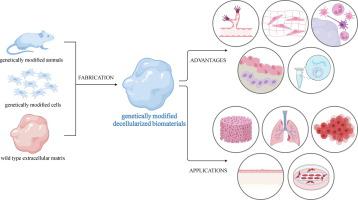Advanced Drug Delivery Reviews ( IF 15.2 ) Pub Date : 2022-06-28 , DOI: 10.1016/j.addr.2022.114413 Danji Zhu 1 , Zhiwei Jiang 1 , Na Li 1 , Xueting Wang 1 , Lingfei Ren 1 , Yuer Ye 1 , Yiqi Pan 1 , Guoli Yang 1

|
Various modifications have been performed on biomaterials to improve their applications in tissue engineering and regenerative medicine. However, the challenges of immunogenicity and biocompatibility existed since the application of biomaterials. As a method to solve this problem, the decellularization process removes most living cells from biomaterials to minimize their immunogenicity; and preserves the native structures and compositions that favour cell growth and the subsequent construction of functional tissue. On the other hand, genetic modification of biomaterials aims to achieve specific functions (low immunogenicity, osteogenesis, etc.) or analyse the genetic mechanisms underlying some diseases (cardiac dysfunction, liver fibrosis, etc.). The combination of decellularization and gene modification is highly superior to biomaterials; thus, we must obtain a deeper understanding of these novel biomaterials. In this review, we summarize the fabrication approaches and current applications of genetically modified decellularized biomaterials and then discuss their disadvantages and corresponding future perspectives.
中文翻译:

深入了解转基因脱细胞生物材料在组织工程和再生医学中的应用
对生物材料进行了各种修改,以改善其在组织工程和再生医学中的应用。然而,自生物材料应用以来,免疫原性和生物相容性的挑战就一直存在。作为解决这一问题的一种方法,脱细胞过程从生物材料中去除了大部分活细胞,以最大限度地降低它们的免疫原性;并保留有利于细胞生长和功能组织后续构建的天然结构和成分。另一方面,生物材料的基因修饰旨在实现特定功能(低免疫原性、成骨等)或分析某些疾病(心功能不全、肝纤维化等)的遗传机制。脱细胞与基因修饰相结合,高度优于生物材料;因此,我们必须对这些新型生物材料有更深入的了解。在这篇综述中,我们总结了转基因脱细胞生物材料的制备方法和当前应用,然后讨论了它们的缺点和相应的未来前景。











































 京公网安备 11010802027423号
京公网安备 11010802027423号